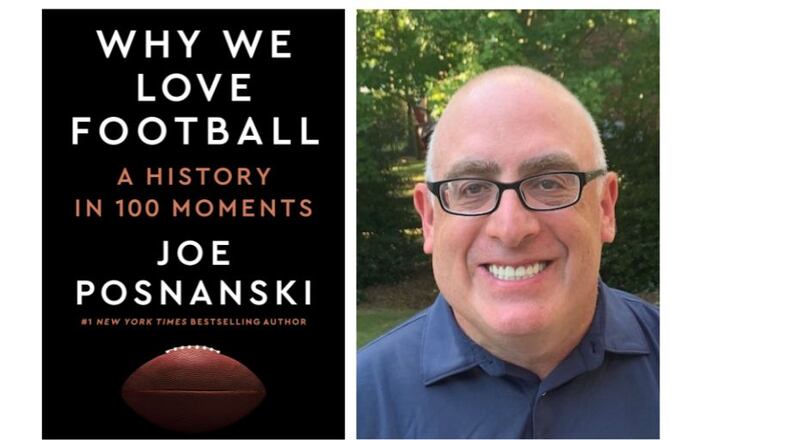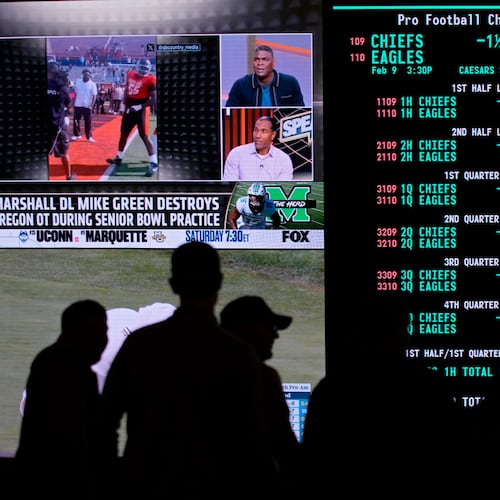It’s undeniable that America has a love affair with football. The National Football League is the most prosperous professional sports organization in the world, with NFL Commissioner Roger Goodell forecasting $25 billion in annual revenue by 2027.
But precisely why America loves football, that is the question former Sports Illustrated journalist Joe Posnanski seeks to answer in “Why We Love Football: A History In 100 Moments,” his eighth book exploring how American sports impact the national consciousness.
Before Posnanski kicks off his highlights reel of the legends and foibles that comprise football lore, he defines precisely who the fans are that have turned this national pastime into an economic giant. Describing football as a “bloodlust” sport, he writes in the book’s introduction that “all football fans, I think, are at least a little bit fatalistic.” Posnanski digs into the late comedian George Carlin’s comparison of football and baseball to prove his point.
“Baseball begins in the spring, the season of new life,” Carlin famously said on “Saturday Night Live” in 1975. “Football begins in the fall, when everything’s dying.”
Posnanski expands on Carlin’s theory in an argument certain to inspire a few chuckles. Focusing on the embedded messaging in each sport, he points out that baseball calls for a seventh-inning stretch, while football gives a two-minute warning. Football measures yards in downs, while baseball focuses on who’s up next.
Tailgating is decidedly not the same experience at the two games. Sure, there’s a difference in weather. But it’s also about the way rival fans are treated at the stadiums. Football is angry, it’s urgent. There’s a risk of injury that transfers from player to fan that isn’t as outsized in baseball. Even the technical term for the version of the game played in this country, gridiron football, has a hard edge to it.
Yet “baseball fans are football fans. And football fans are baseball fans,” Posnanski concludes. And as the author of the 2023 compilation “Why We Love Baseball,” he is certainly qualified to commentate on both sports. So why do the same people who behave with decorum and joviality in the summer act like rabid derelicts in the winter?
To answer that question, Posnanski has compiled 100 short stories about the sport, ranked from last to first. They range from humorous to shocking, occurring both on and off the field, and spanning over 100 years of gameplay from high school through the pros. By focusing on a humanistic angle, Posnanski’s list provides an engaging and accessible trip down memory lane for anyone who possesses even a passing interest in the game.
The first story sets the collection’s tone with a tug on the heartstrings. In 2019, Los Angeles Rams defender Aaron Donald was so certain his team was going to win the Super Bowl, he promised his 5-year-old daughter they would make snow angels in the celebratory confetti. Both father and daughter were crushed when the New England Patriots won in what is still the lowest-scoring Super Bowl in history.
Fast forward three years to the Rams Super Bowl LVI against the Cincinnati Bengals. Donald made a game-winning play in the fourth quarter and was immediately asked for an interview. With his smile fixed on his daughter, Donald answered the reporter saying, “Excuse me. We’re going to play in the confetti for a minute, man.” And that is Posnanski’s 100th greatest moment in football history.
Posnanski’s list undoubtedly provides football fans with an opportunity to do what we love best — relive the glory days while trash-talking each other’s teams. But he also delivers an education on how football has touched different aspects of history. The result hasn’t always been pretty.
During the 1970s energy crisis, the aluminum company Alcoa faced consumer blowback for using 4% of the nation’s energy to produce its product. So they created an ad campaign called “Fantastic Finishes,” pairing Alcoa’s name brand, the signature sound of blaring trumpets and a 30-second clip of a spectacular game ending. The commercials successfully skyrocketed Alcoa’s approval rating to above 70%. With a boost in public perception, they continued burning energy unimpeded while the rest of the country rationed gasoline. Fantastic Finishes, not Alcoa, are what landed this on Posnanski’s list.
“Why We Love Football” is rife with statistics and play-by-play action any die-hard enthusiast will relish. There is plenty to debate as the book drives down the field toward the top moment in football history. Personally, this New York Giants fan put in a bid for Eli Manning’s 2008 “Helmet Catch” (No. 8 on Posnanski’s list).
The NFL ranks the “Immaculate Reception” No. 1 on its list of 100 Greatest Plays. And that was indeed a spectacular play. In a 1972 playoff game, a Pittsburgh Steelers “Hail Mary” pass ricocheted off a player and landed in the hands of a passing receiver, who ran the game-winning touchdown — on Christmas Day. Spoiler alert: The Immaculate Reception is not Posnanski’s No. 1.
“Does football matter?” Posnanski asks as the book ascends into his top 10 moments. And by this point, he has proven it certainly does. He reminds us that football helped heal the country after JFK’s assassination, 9/11 and Hurricane Katrina, to name but a few of our national tragedies.
He ultimately proves that football “takes us fans to the mountaintop, and it tears our hearts out. It lifts us and crushes us, thrills us and revolts us, leaves us empty and leaves us wanting and leaves us breathless.” Football is family, it is religion. Football “illustrates life at its most exuberant and most passionate.” And Joe Posnanski’s “Why We Love Football” is a joyful journey through the best of it.
NONFICTION
“Why We Love Football: A History In 100 Moments”
by Joe Posnanski
Dutton, 416 pages, $30
About the Author
Keep Reading
The Latest
Featured



